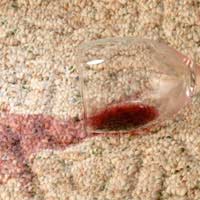
Just like in many other aspects of life, there are many urban myths surrounding stains and their removal. Sometimes, these myths and misconceptions are handed down from generation to generation, with each of us believing that our mothers and grandmothers must know best about domestic cleaning. Other times, they are spread by friends and colleagues who are quick to misconstrue a single incident.
So read on to find out some of the most common myths and misconceptions about stains:
Myth 1 – Fast Action Means You Need to Get Scrubbing Immediately!
We are often told that stains need to be tackled fresh – the quicker they are treated, the higher the chances of their removal. However, many people interpret this as meaning attacking a stain with a scrubbing brush or rubbing it violently with a wet towel immediately, when this could actually be the worst thing they could do. While it is true that fast action will help greatly in stain removal, the right method is even more important. Harsh, abrasive, scrubbing motion is almost never a good idea – in fact, it tends to push the stain in deeper and can also damage the surface or the fabric. When faced with a stain, the best thing is to take stock of the situation, ascertain what type of stain it is (i.e. What is it made of?) and what type of surface it is on – and then work carefully and methodically to remove the stain.
Myth 2 – If in Doubt, Use Bleach!
This should really be re-written as “If in doubt, never use bleach!”. Too many people see bleach as the ultimate solution to all cleaning and stain problems. After all, bleach is the ultimate cleaner, isn’t that right? In actual fact, bleach isn’t so much a cleaner as a disinfectant, killing micro-organisms it comes into contact with. It also coincidentally has bleaching properties which means that it often works on tough stains where other solutions have failed. However, take note – bleach is an indiscriminate stain remover. In other words, it doesn’t just strip your stain – it will also very likely strip all colour from your fabrics. For this reason, it is usually the last resort in any stain removal process.
Myth 3 – More Soap or Detergent Equals Greater Stain Removing Power!
Another common myth – that the more soap or detergent used, the better. In actual fact, soaps and detergents can often cause more problems than they fix. Particularly with stains, too much soap or detergent means that residues can’t be fully rinsed away – which means that they will attract dirt and grime and make the fabric or surface even more prone to stains in the future. This is particularly true with carpets.
Myth 4 – The More Stubborn the Stain, the Hotter the Water Needed!
This seems to be a common reaction for a lot of people – to tackle a heavy stain with hot water. In actual fact, this can be the worst thing to do as heat can set a stain, sometimes permanently – especially protein stains, like milk, blood and egg. This is why those stains which you discover in clothing AFTER they have been through a cycle in the dryer are almost impossible to remove. In general, if in doubt about the type of stain, always wash first in cold water and avoid using the dryer until you can be certain that all traces of the stain have been removed,
Myth 5 – Tougher Stains Just Need More Elbow Grease!
Many people believe that the tougher a stain, the harder they have to scrub. All this does is usually push the stain deeper into the fibres. Stains are removed by using the right solvents to “lift” it out of the fabric or off the surface, not by the sheer brute force of scrubbing it out, using harsh abrasives – not unless you want to lift a layer of the surface with the stain!
Many home remedies for stains do work amazingly well but just be careful before adopting any. Even if the techniques seem to work well in some cases, they often do so at the expense of damaging your surface or fabric – or leaving undesirable residue that is even harder to remove.